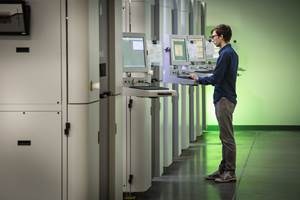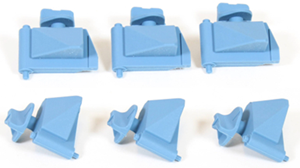Additive Manufacturing Is the New ‘Normal’
One of the first companies founded on the principle of individualized manufacturing puts AM to work right out front in its retail lobby.

Normal founder Nikki Kaufman, wearing her product.
Leaders of large and small businesses are constantly asking the question of how to attract young talent to careers in industry: How do we make manufacturing ‘cool’ again?
Nikki Kaufman has found an answer. Her brand-new company, which launched just last July, has a cool, intriguing name, Normal. It’s located in the hip, artsy Chelsea district of Manhattan’s West Side. Her company makes a product desired by almost any user of a smart phone or digital music player. And Normal makes the product better, faster, and cheaper than anyone else in the world by using the newest, “greenest,” and, some might say, coolest industrial technology—3D printing.
Kaufman, 29, started her company out of a quest for earphones that aren’t uncomfortable to wear for extended periods. She tried dozens of commercial earbuds without success and considered having a custom pair made. But she learned that would involve a visit to a doctor’s office, would take three to six weeks, and cost up to $2000. She decided she could do better on her own.
Last summer, Kaufman launched her brainchild based on the idea of making custom earbuds with a personalized fit in as little as 48 hr and for $199, including shipping and tax. And all you need is a free iTunes or Android app that walks you through steps of photographing your ears, choosing among several color options, and ordering the earphones.
And about her company’s name: “What is a normal ear shape? There’s no such thing. Everyone’s is different,” Kaufman explains. “Even your left and right ears can differ by up to 20%.”

Kaufman in front of two of her 10 Stratasts 3D printers.
Normal has joined the small handful of companies today (apart from service bureaus) whose business model is based on making proprietary products with additive manufacturing, or 3D printing as it’s commonly known. Standing in the store, you probably won’t immediately notice (this reporter didn’t) that you’re also in the factory area. Set flush into the walls are eight Fortus 250mc 3D printers from Stratasys, Ltd., Eden Prairie, Minn. There are two more of these printers on another floor, along with two Stratasys smoothing stations, two paint booths, two cleaning stations, and one laser cutter.
The 3D printers use the Fused Deposition Modeling (FDM) technology, which extrudes fine molten strands of thermoplastic—ABS, in this case—in thin layers according to a “sliced” CAD model of the part.
FDM is used to produce the earpiece that fits your ear cavity. Seven colors are available. It is soft-touch coated and assembled with a handful of purchased components, including an injection molded and UV-coated ABS/PC “inner cabinet,” the 14-mm audio speaker, CNC anodized aluminum “outer cabinet,” a brass tube, coaxial connector, and 360° rotating CNC anodized aluminum cable housing.
Normal has another use for FDM—to make tools like jigs and fixtures for its own internal manufacturing needs. That’s in line with what Stratasys CEO David Reis sees as the main near-term market opportunity for FDM—jigs, fixtures, and molds, also referred to as “augmented manufacturing”—rather than “direct digital manufacturing” (DDM) of end products, as Normal is doing.
(More details on Normal’s use of FDM will appear in a special supplement on Additive Manufacturing to accompany the February issues of Plastics Technology, MoldMaking Technology, and Modern Machine Shop magazines.)
Related Content
Getting into Plastics Additive Manufacturing? Avoid these Six Common Errors
There are a lot of 3D printing technologies out there, and it’s not uncommon for processors new to additive manufacturing to get tripped up. Here are some typical snafus, along with advice on how to avoid them before you start making parts.
Read MoreFreeform Injection Molding Eases the Path to Medical Device Product Testing
A development and manufacturing service provider is using dissolvable molds to build injection molded silicone prototypes.
Read MoreAdditive Technologies for Injection Mold Tooling Ride Tailwinds
NPE2024: Lowering barriers to additive manufacturing adoption in toolmaking.
Read MoreBusiness Slowing? There's Still Plenty of Stuff to Do
There are things you may have put off when you were occupied with shipping parts to customers. Maybe it’s time to put some of them on the front burner.
Read MoreRead Next
For PLASTICS' CEO Seaholm, NPE to Shine Light on Sustainability Successes
With advocacy, communication and sustainability as three main pillars, Seaholm leads a trade association to NPE that ‘is more active today than we have ever been.’
Read MoreSee Recyclers Close the Loop on Trade Show Production Scrap at NPE2024
A collaboration between show organizer PLASTICS, recycler CPR and size reduction experts WEIMA and Conair recovered and recycled all production scrap at NPE2024.
Read More
























